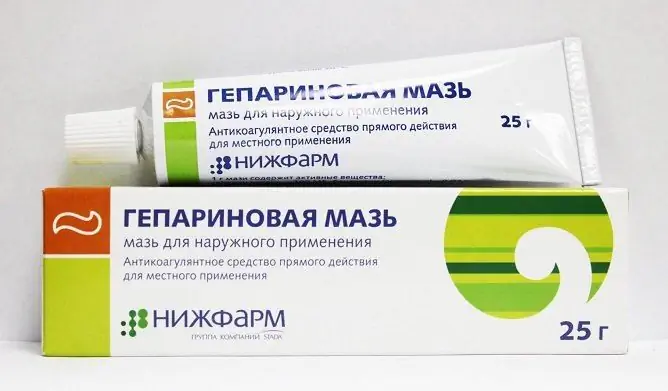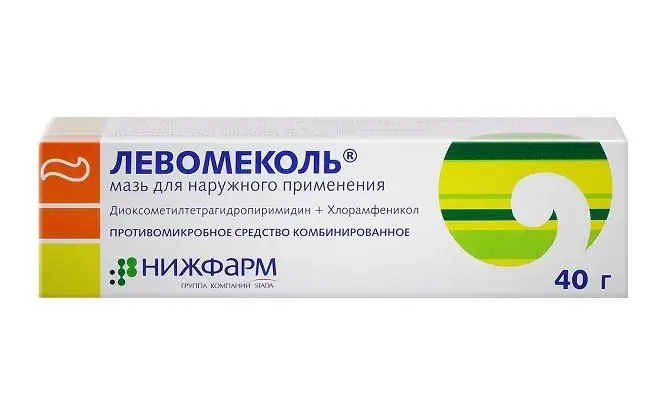- Author Rachel Wainwright [email protected].
- Public 2023-12-15 07:39.
- Last modified 2025-11-02 20:14.
Oxycort
Oxycort: instructions for use and reviews
- 1. Release form and composition
- 2. Pharmacological properties
- 3. Indications for use
- 4. Contraindications
- 5. Method of application and dosage
- 6. Side effects
- 7. Overdose
- 8. Special instructions
- 9. Application during pregnancy and lactation
- 10. Use in childhood
- 11. Drug interactions
- 12. Analogs
- 13. Terms and conditions of storage
- 14. Terms of dispensing from pharmacies
- 15. Reviews
- 16. Price in pharmacies
Latin name: Oxycort
ATX code: D07CA01
Active ingredient: hydrocortisone (hydrocortisone) + oxytetracycline (oxytetracycline)
Manufacturer: Tarkhominsk pharmaceutical plant Polfa AO (Poland)
Description and photo updated: 2019-27-08
Prices in pharmacies: from 347 rubles.
Buy

Oxycort is a combined external preparation that has anti-inflammatory and antibacterial effects.
Release form and composition
- Aerosol for external use: a suspension of uniform consistency, yellow, has no mechanical impurities, has a characteristic odor (55 ml each in aerosol bottles equipped with a valve with a spray device, 1 bottle in a cardboard box);
- Ointment for external use: uniform consistency, yellow (10 g each in aluminum tubes, 1 tube in a cardboard box).
Each carton also contains instructions for the use of Oxycort.
Active substances in 1 aerosol bottle and 1 tube of ointment:
- Oxytetracycline hydrochloride - 300 mg;
- Hydrocortisone 100 mg
Auxiliary components of the aerosol: a mixture of butane, propane and isobutane (Drivosol 35A), lecithin, sorbitan trioleate (Span 85V), isopropyl myristate.
Additional substances of the ointment: white petroleum jelly.
Pharmacological properties
Pharmacodynamics
Oxycort is a drug for external use with anti-inflammatory, antibacterial, antipruritic and anti-allergic action, which is explained by the properties of its active components.
Oxytetracycline is a broad-spectrum antibacterial agent from the tetracyclines group. It inhibits translation during protein synthesis in microbial cells, due to which it has bacteriostatic activity against certain gram-positive bacteria: Staphylococcus spp. (including those producing penicillinase), Streptococcus spp. (including Streptococcus pneumoniae), Bacillus anthracis, Clostridium spp., Listeria monocytogenes; gram-negative bacteria: Pasteurellaceae (Haemophilus spp.), Pseudomonadaceae, Enterobacteriaceae, Shigella spp., Salmonella spp., Escherichia coli, Bordetella pertussis, Klebsiella spp., cocci (Neisseria spp.). It has an effect on microorganisms of the family Rickettsiaceae, Actinomyces, Mycoplasma, Chlamydiaceae, Spirochaetaceae, Mycobacterium spp. and some protozoa (Plasmodium, Entamoeba).
Hydrocortisone is a synthetic glucocorticosteroid of the adrenal cortex with anti-inflammatory, anti-edema, antipruritic and anti-allergic effects.
The drug inhibits protein synthesis, inhibits phospholipase A 2, disrupts the connection between the transport RNA and the ribosomal membrane in microbial cells, reduces the synthesis of prostaglandins and other biologically active substances. It reduces the migration of macrophages and lymphocytes, changes the structure and reduces the permeability of tissue and cell membranes, blocks the release of histamine and other biologically active substances from sensitized mast cells and basophils, and affects all phases of inflammation.
The drug is effective in allergic and inflammatory skin diseases complicated by secondary bacterial infection.
Pharmacokinetics
The active components of Oxycort aerosol and ointment accumulate in the epidermis, mainly in the granular layer.
When applied externally, oxytetracycline is practically not absorbed into the bloodstream, therefore it does not have systemic effects. A small amount of the substance after resorption is biotransformed in the liver and excreted by the kidneys.
Hydrocortisone penetrates the epidermis. In small amounts, it can be absorbed into the bloodstream and, as a result, cause systemic effects inherent in glucocorticosteroids. It is metabolized directly in the epidermis, and the part that is absorbed into the general bloodstream is in the liver. In the blood, 80% binds to transcortin, 10% - to albumin. It is excreted by the kidneys mainly in the form of metabolites; only a small amount of the substance is excreted unchanged. A small volume of the substance is excreted in the bile.
The absorption of the drug is enhanced in the following cases: frequent use of ointment, use on large areas of the skin, application to the skin of the face or in the area of skin folds, violation of the integrity of the skin, inflammatory and other pathological skin processes, the use of occlusive dressings (since they increase the local temperature and humidity).
In children, absorption of hydrocortisone from the skin is more pronounced than in adults. There is also a high predisposition to the systemic action of the drug. In this regard, children should use Oxycort on limited areas of the skin and as short a course as possible.
Indications for use
- Bacterial skin infections caused by microorganisms susceptible to oxytetracycline (staphylococcal, streptococcal, mixed), complicated by local allergic reactions: carbuncle, folliculitis, erysipelas, furuncle, furunculosis, pyoderma (staphylococcal, streptococcal, neonatal), impetigoalous dermatitis;
- Allergodermatoses complicated by the addition of a bacterial infection (staphylo-, streptoderma): atopic dermatitis (widespread neurodermatitis), erythroderma, seborrhea, erythema multiforme, psoriasis, eczema (including in children), prurigo (pruritus), pruritus, dermatoses, urticaria (including contact, solar, allergic, professional);
- Varicose leg ulcers;
- Frostbite;
- I-II degree burns;
- Insect bites.
Contraindications
Absolute:
- Neoplasms and precancerous skin diseases;
- Viral and fungal infections;
- Lupus;
- Perioral dermatitis;
- Rosacea;
- Dermatomycosis;
- Syphilis;
- Skin reactions after vaccination;
- Pregnancy and lactation period;
- Hypersensitivity to the components of Oxycort.
Oxycort, instructions for use: method and dosage
The drug is intended for external use.
Oxycort ointment should be applied in a thin layer to the lesions, if necessary, apply an occlusive gauze bandage.
Spray the affected areas with aerosol for 3 seconds. The bottle must first be shaken well. The drug should be sprayed from a distance of 15-20 cm from the skin surface.
Frequency rate of procedures: for ointment - 2-3 times a day, for aerosol - 2 to 4 times a day.
The course of treatment is 1-2 weeks.
Children (especially under 2 years old) are allowed to apply Oxycort on limited areas of the skin, it should be applied in a short course (no more than 7 days).
Side effects
- Local reactions: irritation, itching and burning at the site of application of the drug, acne-like rash, dryness and atrophy of the skin, secondary infections; with prolonged use on the skin of the face - dilation of blood vessels, skin atrophy, steroid acne, striae, telangiectasia;
- Systemic actions: when Oxycort is applied to large areas of the body and / or over a long period - inhibition of the hypothalamic-pituitary-adrenal system.
Overdose
Overdose cases have not been reported.
special instructions
Oxycort should not be used for a long time on large areas of the skin.
Avoid contact with eyes. If the drug gets on the mucous membranes, rinse them abundantly with cool water.
Do not inhale sprayed aerosol.
Treatment of diseases on the face and skin folds should be as short as possible (no more than 7 days).
Do not apply Oxycort ointment and aerosol to large skin surfaces, since there is a risk of side effects inherent in systemic steroid drugs, including such a serious phenomenon as suppression of the hypothalamic-pituitary-adrenal system (including glucosuria and symptoms of Cushing's syndrome). If this happens, treatment should be interrupted and urinary cortisol levels monitored.
If irritation appears at the site of application, it is necessary to cancel Oxycort and conduct appropriate therapy.
Oxytetracycline, like other broad-spectrum antibacterial agents, can lead to an increase in the number of resistant strains of staphylococci and candida albicans. If such an infection develops, appropriate therapy is also necessary.
It is forbidden to heat and open the bottle, because its contents are under pressure and flammable.
Influence on the ability to drive vehicles and complex mechanisms
Oxycort does not limit psychomotor activity, does not affect the ability to drive a car and work with complex mechanisms.
Application during pregnancy and lactation
Oxycort is contraindicated for pregnant and breastfeeding women.
Pediatric use
In children, especially under the age of 2 years, Oxycort ointment and aerosol should be used with extreme caution, applying the agent to limited areas of the skin and taking the shortest possible course of treatment.
Drug interactions
Preparations containing oxytetracycline should not be used simultaneously with preparations of silver and lead, because they mutually inactivate each other's actions.
During the period of therapy, one should not be vaccinated against smallpox and plan other types of immunization, since Oxycort has an immunosuppressive effect.
In case of improper or prolonged use of the drug on large areas of the skin, especially under occlusive dressings, hydrocortisone reduces the effectiveness of anticoagulants, antihypertensive drugs, insulin and oral hypoglycemic drugs, and also reduces the concentration of salicylates and praziquantel in the blood.
With the simultaneous use of the following drugs, the risk of side effects increases:
- Anabolic steroids, oral contraceptives, estrogens, androgens - acne and hirsutism;
- Cardiac glycosides - digitalis intoxication;
- Diuretics - hypokalemia;
- Tricyclic antidepressants, antihistamines, nitrates, anticholinergics - glaucoma;
- Azathioprine, bukarban, antipsychotics - cataract.
Analogs
Oxycort analogs are: Hyoxysone, Oksizon, Geokorton.
Terms and conditions of storage
Keep out of the reach of children at a temperature not exceeding 25 ºС.
Shelf life is 2 years.
Terms of dispensing from pharmacies
Dispensed by prescription.
Reviews of Oxycort
On specialized medical sites and forums, there are mainly reviews about Oxycort in the form of an aerosol. Patients note the high efficacy of the drug, ease of use, and good tolerance.
In isolated negative reports, side effects have been described, including skin atrophy, hyperpigmentation, dilated superficial capillaries, acne-like rash on the body and face.
Price for Oxycort in pharmacies
The cost of the ointment is currently unknown due to its lack in free sale. The price of Oxycort in the form of an aerosol for external use is approximately 390-437 rubles. for 1 bottle.
Oxycort: prices in online pharmacies
|
Drug name Price Pharmacy |
|
Oxycort 10 mg + 30 mg / g aerosol for external use 55 ml 1 pc. 347 r Buy |

Maria Kulkes Medical journalist About the author
Education: First Moscow State Medical University named after I. M. Sechenov, specialty "General Medicine".
Information about the drug is generalized, provided for informational purposes only and does not replace the official instructions. Self-medication is hazardous to health!






